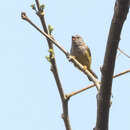en
names in breadcrumbs


Die Baumsänger (Hyliidae) sind eine aus zwei Arten bestehende Singvogelfamilie, die in Wäldern im tropischen West- und Zentralafrika vorkommt.
Die zwei Arten sind:
Baumsänger sind kleine Vögel, die ein Gewicht von 5 bis 14 Gramm erreichen und sich vor allem von Insekten, darunter speziell von Napfschildläusen (Coccidae) ernähren. Sie leben in kleinen, sozialen Gruppen, die zusammen im Nest schlafen. Die Nester sind kugelförmig, ähnlich wie die Nester der Webervögel (Ploceidae). Die Eier der Baumsänger sind weiß.[1]
Über die systematische Einordnung der beiden Baumsängerarten waren sich die Ornithologen über einen langen Zeitraum nicht einig und sie wurden im Laufe der Zeit zusammen oder getrennt den Mistelfressern (Dicaeidae), Prachtfinken (Estrildidae), Honigfressern (Meliphagidae), den Nektarvögeln (Nectariniidae), den Meisen (Paridae), den Webervögeln, den Laubsängerartigen (Phylloscopidae), den Beutelmeisen (Remizidae) oder den Grasmückenartigen (Sylviidae) zugeordnet. Die meisten Autoren stellten die zwei Arten getrennt in verschiedene Familien.[1]
DNA-Vergleiche zeigen jedoch das die zwei Arten nah miteinander verwandt sind. Sie werden deshalb heute in die Familie Hyliidae gestellt,[2][3] die schon im Jahr 1930 durch den amerikanischen Ornithologen George Latimer Bates eingeführt,[4] von späteren Autoren aber nicht akzeptiert wurde. Gemeinsame morphologische Merkmale der zwei Arten sind die mit einer bürstenartigen Spitze versehene Zunge und das lange Zungenbein.[2][1]
Die Baumsänger (Hyliidae) sind eine aus zwei Arten bestehende Singvogelfamilie, die in Wäldern im tropischen West- und Zentralafrika vorkommt.
Die zwei Arten sind:
der Grünbaumsänger (Hylia prasina) und der Strichelbaumsänger (Pholidornis rushiae)
Hyliidae is a family of passerine birds which contains just two species, the green hylia (Hylia prasina) and the tit hylia (Pholidornis rushiae). Physiological similarities and molecular phylogenetic studies strongly support the creation of this family.[1][2][3][4]
Some taxonomic authorities place the entire family in the Macrosphenidae.
Hylias are small, insectivorous songbirds found in tropical Africa. They frequent the understory of wet tropical forests.
The family Hyliidae was introduced in 1923 by the British ornithologist David Bannerman.[5] The family contains just two species, each of which is placed in its own genus.[1]
AegithaloideaPhylloscopidae – leaf warblers (80 species)
Hyliidae – hylias (2 species)
Aegithalidae – bushtits (13 species)
Erythrocercidae – flycatchers (3 species)
Scotocercidae – streaked scrub warbler
Cettiidae – bush warblers and allies (32 species)
Cladogram showing the family relationships based on a study by Carl Oliveros and colleagues published in 2019.[2] The number of species is taken from the bird list maintained by Frank Gill, Pamela Rasmussen and David Donsker on behalf of the International Ornithological Committee (IOC).[1]Hyliidae is a family of passerine birds which contains just two species, the green hylia (Hylia prasina) and the tit hylia (Pholidornis rushiae). Physiological similarities and molecular phylogenetic studies strongly support the creation of this family.
Some taxonomic authorities place the entire family in the Macrosphenidae.
Hylias are small, insectivorous songbirds found in tropical Africa. They frequent the understory of wet tropical forests.